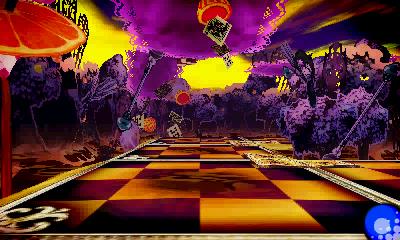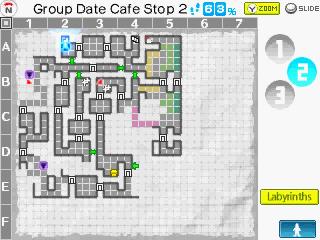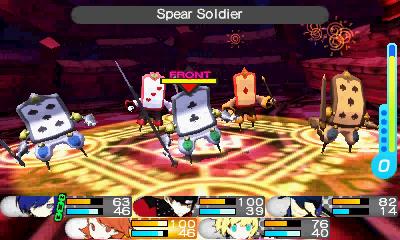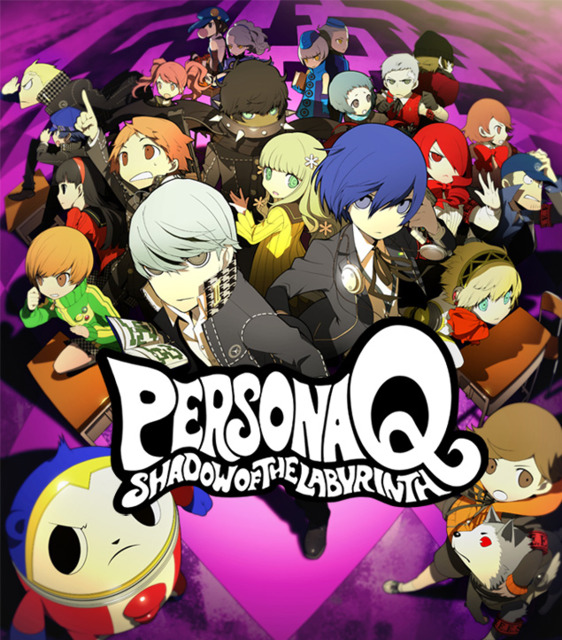Hey! You got your Persona in my Etrian!
Persona Q: Shadows of the Labyrinth is a marriage of Atlus’ Persona 3 and 4 with Etrian Odyssey, called Sekaiju no MeiQ in Japan. Specifically, it’s a merge of the Persona characters into a world with mechanics inspired by the Etrian games. While it might seem like nothing more than an entertaining side-project, Persona Q creates a unique experience that gives a fresh perspective on the RPG franchise.
The story of Persona Q takes place somewhere in between the two universes of Persona 3 and 4. For an unknown reason, the characters of Persona 3 are all swept into the Velvet Room, a place outside of time and space shaped like an elevator, that only the main character normally has access to. The elevator crashes with the Persona 3 cast emerging in an odd world modeled after a high school festival. There they meet Zen and Rei, a pair of amnesiac students that seem to have some sort of tie to this world in between worlds. Later, the group discovers a pair of doors with a series of locks on them inside the now collapsed Velvet Room, which supposedly lead back to their original universe. These locks are paired with a series of dungeons placed around the school, and by completing one a lock is removed and Zen and Rei recover a bit of their memories.
Upon starting the game you’re prompted with choosing either the Persona 4 or Persona 3 side of the story. The difference between the two paths is what smaller scenes you get. The Persona 3 hero interacts mostly with his fellow SEES members, while the Persona 4 hero interacts with his investigation team. Whichever team you didn’t choose ends up coming to your rescue at the end of the first dungeon, effectively doubling your party size, and giving you more options for team building.

The story remains rather detached from the characters and focuses more on the mystery of the out of place school festival. Persona Q takes the approach that the player probably has prior experience with all the characters from their respective games. This minimalistic approach to story is something taken from the Etrian franchise, which normally involves delving into a series of dungeons with your goal being exploration while feeding you tidbits of lore along the way with a huge exposition as you near the end. Persona Q operates in a very similar fashion, so people expecting a narrative similar to Persona 3 or 4, might be left with a little less than what they hoped for. Upon reaching new floors in dungeons you can unlock small skits in what the game calls a “stroll,” where your selected main character hangs out with the other cast members for a while. It’s a nice break in between floors, and offers some fun interactions between the characters.
The dungeons in Persona Q are navigated by walking through them one tile at a time. The top screen shows the environment in a first person perspective while the bottom screen serves as a map. Each dungeon is vastly different from the one before it in terms of visual style which helps keep the game feeling fresh and new with each labyrinth. In particular, a favorite of mine is the third dungeon which draws inspiration from horror genre tropes. The in game music only helps to enhance the aesthetics. Be it ambient background music of the dungeons or the comical pieces that play during certain skits, the music is spot on and is a pleasure to listen to.
One of the defining qualities of the Etrian series is the fact that the player has to draw their own map by marking walls and areas of interest, and Persona Q imports this idea. Learning to properly chart dungeons is important, as later on the game introduces plenty of puzzles based around the map layout and presents scenarios where you’ll have to find the quickest way from point A to point B or learn how to navigate around enemies by moving on certain tiles.

Map making is fun though, and there are plenty of options to mark everything from indicators for wall switches down to different colored tiles for floor traps. There are also plenty of dead ends and corners that can lead to various side-quests and events, making exploration important and rewarding. On every dungeon floor there is a treasure chest that opens if you successfully navigate 100% of the area. Most of these contain rare materials or items that can be used to make your treks through the labyrinth a bit easier.
Combat is a unique mesh of Etrian’s and Persona’s mechanics. From Etrian comes the concept of a front and back line. Characters with ranged weapons tend to do better on the back line where they can attack safely, while characters with melee weapons tend to do better up front. Characters placed on the back line will take less damage from physical skills but do less damage if their weapon isn’t ranged, and characters on the front line take more damage but at the same time do more damage than if they were placed on the back.

From Persona comes the use of a resource system and weakness and resistance system. Magic-based abilities cost SP, while physical ones cost HP. Since these spells are pricy it’s good to get familiar with the weakness and resistance system early on. Exploiting an element an enemy is weak too, or landing a critical hit with a physical move, gives your character a buff that removes the resource cost for their next turn on top of giving them turn priority over everyone else. If your character gets hit before the next turn cycle though the buff gets removed. If a large enough number of your characters get the weakness exploit buff there’s a chance one of them will do an extra attack dealing a large amount of damage or call your party to do an All-Out Attack which is roughly the same thing.
Your party members also have weaknesses tied to their persona, so if those get exploited they take extra damage. There is also the possibility of a knockdown, which renders their actions for the turn null, assuming they haven’t gone yet. You can increase your party’s variety of attacks and resistances by equipping sub-personas, which you can obtain after random encounters or by fusing these battle obtained personas together in the Velvet Room. Balancing your team is import, and while the game gives some leeway on the easier difficulties on who you take into combat, if you take a team of five front line people or a bunch of back line casters the game is not going to take any mercy in pointing out your mistake. All of these elements make for engaging and fun combat that rewards you for planning out your team and sub-personas carefully.
Persona Q is a great game, but one with a niche audience in mind. While anyone could actively enjoy it for the dungeon crawling and combat alone, the lack of an introduction to the crossover cast might make the game harder to get into for players not familiar with Persona. So while it might not appeal to a more casual RPG player, for fans of the Persona franchise it is not a game worth missing.
